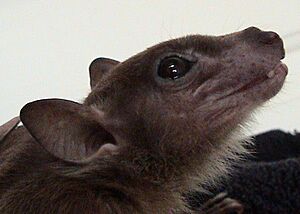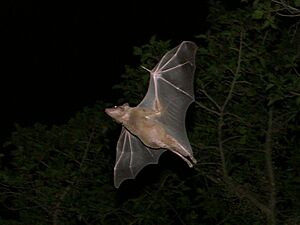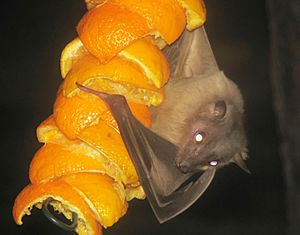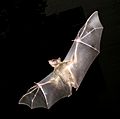Egyptian fruit bat facts for kids
The Egyptian fruit bat (Rousettus aegyptiacus) is a type of bat that eats fruit. It lives in many parts of Africa, but not in the Sahara desert. You can also find it across the Middle East, reaching as far as Pakistan and northern India.
Contents
About the Egyptian Fruit Bat
The Egyptian fruit bat is smaller than some other fruit bats. Its wings can spread about 60 cm (2 ft) wide. Its body is around 15 cm (6 in) long. These bats usually weigh about 160 g (5.6 oz). Male bats are often bigger than females.
This bat is usually light brown with darker brown wings. It has big, pointed ears and dark eyes. Its long, dog-like nose makes some people call it a "flying fox". Its fur is very soft, and its wings feel like thin fabric.
How They Behave
Like many bats, Egyptian fruit bats are active at night. They spend their days resting in trees or caves. They often roost in huge groups, sometimes with thousands of other bats.
They leave their roosts in the late evening to find food. They return just before the sun comes up. When they rest, they hang upside down. Their wings are folded tightly around their bodies.
Egyptian fruit bats are special because they use echolocation. This means they use sound to "see" their surroundings. They make sharp clicking sounds with their tongues. These clicks are usually slow, but they speed up a lot when the bats get close to something.
They also use many different sounds to talk to each other. These sounds include grunts and screeches. Because of this, a large group of bats resting together can be very noisy!
What They Eat
Egyptian fruit bats are frugivores, which means they eat mostly fruit. They eat a lot of fruit every night. Wild dates are a favorite food. However, they will eat almost any soft, juicy fruit.
They often eat fruit that is not fully ripe. They also eat fruit that has been damaged by insects or fungi. This helps them survive in places where ripe fruit is not available all year.
How They Reproduce
Egyptian fruit bats become adults at about nine months old. Females usually give birth to one baby bat each year. Sometimes, twins are born. The mother carries her baby for about 115–120 days before it is born.
The mother carries the young bat until it can hang from the roost by itself. This happens after about six weeks. Then, the baby is left in the roost while the mother goes to find food. Once the baby bat can fly, at about three months old, it will leave the roost to find its own food. Young bats usually stay with the same group as their parents for their whole lives.
In Zoos
The Egyptian fruit bat is a common sight in zoos around the world. They can have babies easily in zoos. They also adapt well to eating common fruits and nectar given to them by people.
Important Concerns
These bats are very important for nature. They help many trees and plants by pollinating their flowers or spreading their seeds. For example, the baobab tree relies almost entirely on fruit bats to pollinate its flowers.
However, fruit bats also eat fruit crops that farmers grow for people. Because of this, farmers sometimes try to get rid of the bats to protect their crops.
Egyptian fruit bats can carry certain viruses, like Marburg and Ravn. These viruses are similar to the Ebola virus. The bats themselves usually don't get sick from these viruses.
Images for kids
-
A colony of Egyptian fruit bats in a roost at Ha-Teomim cave in Israel.
See also
 In Spanish: Murciélago egipcio de la fruta para niños
In Spanish: Murciélago egipcio de la fruta para niños








